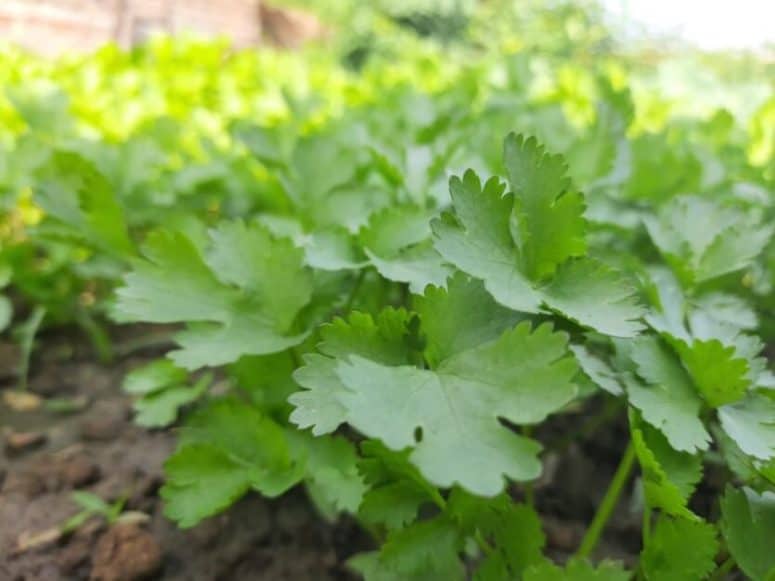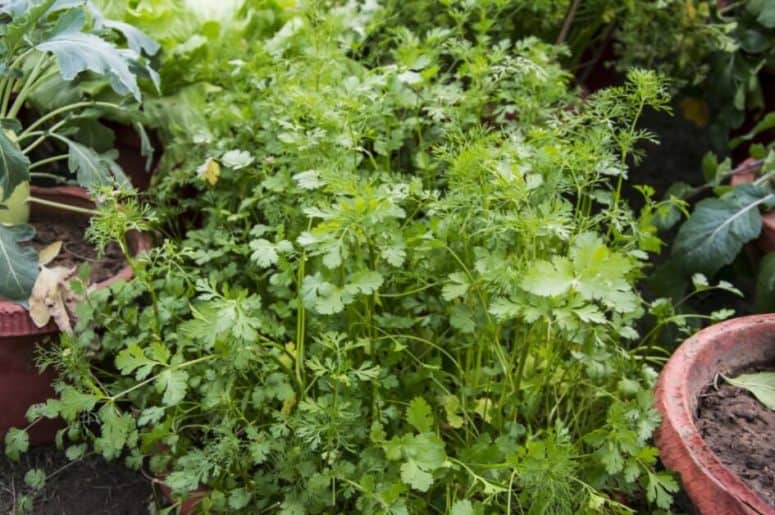Let’s talk about cilantro, the beloved herb renowned for its distinctive flavors in Mexican and Asian cuisines. Its unique pungency and warm sensations add a delightful touch to various dishes.
Chances are you’ve encountered cilantro in the kitchen, its vibrant green leaves with serrated edges catching your eye. While many enjoy using cilantro in their culinary creations, not everyone ventures into growing it themselves, assuming it to be a challenging task. However, I’m here to tell you that growing cilantro at home is surprisingly easy!
If you’re eager to learn more about cultivating cilantro in your own space, you’ve come to the right place. Let’s dive into the world of growing fresh cilantro at home!
Cilantro Varieties
To embark on your cilantro-growing journey, it’s helpful to familiarize yourself with the various varieties available, each offering its own distinct characteristics and culinary applications.
Let’s explore the diverse types of cilantro commonly utilized in traditional cuisines across the globe.
Calypso Cilantro
When it comes to cilantro varieties, Calypso cilantro stands out as an excellent choice, especially in regions with hotter climates. One of its remarkable traits is its slow-bolting nature, meaning it takes longer to produce flowers and go to seed compared to other varieties.
Calypso cilantro offers a delightful combination of citrusy and savory flavors, adding a unique twist to your culinary creations. To savor its full potential, it is recommended to use Calypso cilantro fresh, as its flavors are most vibrant and pronounced when enjoyed immediately after harvesting.
Leisure Cilantro
In the realm of international cuisine, cilantro and coriander often get intertwined. Coriander is commonly used to refer to the dried seeds of the cilantro plant.
On the other hand, cilantro specifically refers to the fresh leaves and stems of the plant, which are widely employed to add a burst of flavor to various dishes.
Leisure cilantro, with its delightful aroma and tendency to slow-bolt, is particularly well-suited for hotter climates. The fragrant leaves of leisure cilantro have a remarkable allure, which can attract certain insects to the plant.
Cruiser Cilantro
Cruiser cilantro is often mistakenly called coriander, as it is primarily associated with the development of glossy and dark green coriander seeds.
This variety of cilantro has a slow-bolting characteristic, allowing it to preserve the delicious and delicate flavors found in its leaves and stems.
Santa Cilantro
Santa cilantro shares many similarities with other cilantro varieties. However, what distinguishes it is its tendency to grow in a slightly bushier manner, giving it the appearance of faster growth compared to other varieties.
Cilantro Cultivation

Soil Requirements
To ensure optimal growth of cilantro, it is crucial to provide it with suitable soil conditions. Ideally, the soil should have a slightly acidic pH ranging from 6.2 to 6.8. Additionally, proper drainage is essential to prevent waterlogging.
Avoid excessive moisture in the soil, as this can lead to premature flowering and a less pronounced flavor in the leaves and stems. It is recommended to maintain a moderately dry soil.
To enhance the growth of cilantro, enrich the soil with compost and organic matter. This will provide essential nutrients and contribute to the overall health and vigor of the plant.
Sun Requirements
Cilantro, like many herbs, thrives in sunlight. However, it prefers a balance of full sun and partial shade.
When selecting a spot to grow cilantro, it is advisable to choose a location in your garden that provides some shade. This will prevent the leaves from getting scorched by intense sunlight.
Excessive exposure to direct sunlight can cause cilantro to bolt more quickly, which means it will rapidly produce flowers and go to seed. To mitigate this, you can opt to cultivate cilantro in pots indoors, ensuring it receives adequate sunlight and appropriate care.
Hardiness
Cilantro, being an annual herb, can withstand light frosts but struggles in hot and humid conditions. In fact, high temperatures cause cilantro to bolt rapidly, resulting in bitter-tasting leaves.
The hardiness of cilantro is largely influenced by the climate in which it is grown. If you reside in cooler regions, such as zones 3 to 8, it is best to plant cilantro in the spring when temperatures are more favorable.
On the other hand, if you live in warmer climates like zones 9 to 11, it is advisable to plant cilantro during the fall or winter when the weather is milder and more suitable for its growth.
Water
When it comes to watering cilantro, it’s important to strike the right balance. You should water the soil once it has dried out, ensuring that it remains moist but not excessively damp.
Avoid allowing the soil to become soggy, as too much water or moisture can be harmful to your cilantro. It’s crucial to provide adequate hydration while also allowing proper drainage to prevent waterlogging.
Fertilizer
Growing cilantro at home is a straightforward process that doesn’t require excessive fertilization. You can save your money and let the plant flourish naturally.
While it’s not necessary, adding organic matter or nutrients to the soil during the initial stages of cultivation can provide a boost to the soil’s health and nourishment. This can help establish a favorable environment for the cilantro to grow and thrive.
Mulch
While not essential, using mulch for cilantro plants can offer several benefits. Mulching helps to suppress weed growth, keeping the area around the cilantro plants clean and reducing competition for nutrients and moisture. Additionally, a layer of mulch, approximately 5 inches thick, can help retain soil moisture, preventing it from evaporating too quickly and ensuring the cilantro plants have a consistent water supply.
Pruning
Promoting vigorous growth in cilantro can be achieved through regular pruning. One effective method is to pinch back the leaves, removing approximately an inch from the top of the plant. This encourages the cilantro to branch out and become bushier.
For even more robust growth, it’s beneficial to regularly snip the soft stems, ensuring to rotate around the plant as you harvest. This approach allows you to harvest from different areas of the plant, stimulating overall growth and ensuring a fuller and more productive cilantro plant.
Division
Certainly! Root division is a viable method for propagating cilantro. By placing cilantro stems in a glass of water, you can encourage root growth. Once the roots have sufficiently developed, you can transfer the cilantro to a pot or directly into the soil.
After undertaking this root division process, you can expect the newly planted cilantro to establish itself and develop into a full-fledged plant within a few weeks. This method offers a simple and effective way to expand your cilantro garden.
Best Methods to Grow Cilantro

The most favored and highly recommended method of planting cilantro is through seed sowing. Growing cilantro from seeds is a simple and rewarding process, as cilantro is a rapid-growing herb. Let’s explore how to go about it:
To begin, prepare the soil by incorporating compost and organic matter, ensuring a depth of at least 18 inches. Smoothly rake the area and proceed with sowing the cilantro seeds.
Plant the seeds approximately 1/4-inch deep in your garden or containers if you prefer indoor cultivation. Space the seeds evenly, leaving 6 to 8 inches between each seed in rows. It is ideal to sow cilantro seeds during the late spring or early summer.
Nurture the seeds by maintaining adequate soil moisture. Once the seedlings reach a height of around 2 inches, you can consider applying water-soluble fertilizer. With proper care, you’ll witness the cilantro plants thriving and multiplying abundantly.
How to Care for Cilantro
Cultivating cilantro entails attentiveness throughout the growth process. It involves various aspects such as propagation, storage, and being mindful of potential pests and diseases.
But fret not! We’ve got you covered with all the essential information you need.
Pests/Disease
Cilantro can face various pests and diseases such as fungal wilt, leafhoppers, whiteflies, mildew, and aphids. Additionally, pests like willow carrot, armyworm, cutworm, and root-knot nematode may also be a concern.
But don’t worry, dealing with these issues is straightforward! Proper watering techniques and the use of antibacterial soap, insecticide, or liquid can help control these pests. Regularly cleaning up debris and removing dead leaves is also beneficial.
When it comes to diseases, cilantro can be susceptible to powdery mildew, damping-off, carrot motley dwarf, soft rot, and bacterial leaf spot. However, avoiding overwatering and ensuring the plant remains dry can help prevent these diseases. It’s as simple as that!
Propagating Cilantro
Propagating cilantro is a simple process. By pinching back the top 1/4 of the stems, you can promote better growth and encourage bushiness in the plant. As cilantro matures, it has the ability to self-sow and produce more plants.
For this reason, it is recommended to directly plant cilantro in the garden instead of transplanting it from a pot. By allowing the plant to reach maturity, you can even harvest the seeds for future seasons, ensuring a continuous supply of cilantro.
Harvesting Cilantro
In just three to four weeks after sowing cilantro seeds in your garden, you can begin the rewarding process of harvesting! It’s that simple!
To harvest your cilantro, wait until it reaches a height of 4 to 6 inches, and then start by cutting the leaves at the bottom of the plant. It’s important to be mindful and avoid harvesting more than one-third of the plant’s foliage, as excessive cutting can hinder its growth. Instead, harvest as needed to encourage continuous growth and a fresh supply of cilantro.
If you’re interested in harvesting cilantro seeds, which are known as coriander, simply clip the seed heads and hang them upside down in a paper bag or similar container. Allow a couple of days for the seeds to dry out before storing them.
Storing Cilantro
Now that you have harvested your delicate cilantro, it’s time to learn how to store it properly.
For cilantro seeds, you can store them in a dry and cool place. If you prefer, you can also crush or grind the seeds to enhance the flavor and use them as a spice in your dishes. If you want to save some seeds for future planting, crack the shell and soak the seeds in water overnight. Dry them thoroughly before storing them for the next season.
When it comes to storing cilantro leaves, the key is to keep them fresh. Dampen a paper towel or kitchen towel, wrap the cilantro leaves gently, and place them in a plastic bag or airtight container in the refrigerator. This method helps maintain their freshness for a longer period. For the best flavor, it’s recommended to add fresh cilantro leaves to your dish towards the end of the cooking process.
By following these storage tips, you can enjoy the vibrant flavors of cilantro in your culinary creations even after it has been harvested.